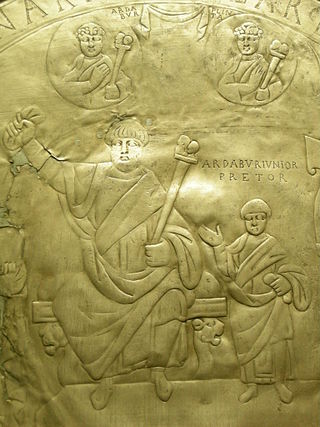
Year 567 (DLXVII) was a common year starting on Saturday of the Julian calendar. The denomination 567 for this year has been used since the early medieval period, when the Anno Domini calendar era became the prevalent method in Europe for naming years.

Gratian was emperor of the Western Roman Empire from 367 to 383. The eldest son of Valentinian I, Gratian was raised to the rank of Augustus as a child and inherited the West after his father's death in 375. He nominally shared the government with his infant half-brother Valentinian II, who was also acclaimed emperor in Pannonia on Valentinian's death. The East was ruled by his uncle Valens, who was later succeeded by Theodosius I.
Abū Ḥanīfa Aḥmad ibn Dāwūd Dīnawarī was a Islamic Golden Age polymath: astronomer, agriculturist, botanist, metallurgist, geographer, mathematician, and historian.

Theudebert II (c.585–612), King of Austrasia, was the son and heir of Childebert II. He received the kingdom of Austrasia plus the cities (civitates) of Poitiers, Tours, Le Puy-en-Velay, Bordeaux, and Châteaudun, as well as the Champagne, the Auvergne, and Transjurane Alemannia.

The Mausoleum of Galla Placidia is a Late Antique Roman building in Ravenna, Italy, built between 425 and 450. It was added to the World Heritage List together with seven other structures in Ravenna in 1996. Despite its common name, the empress Galla Placidia was not buried in the building, a misconception dating from the thirteenth century; she died in Rome and was buried there, probably alongside Honorius in the Mausoleum of Honorius at Old Saint Peter's Basilica.

Arcadia or Arcadia Aegypti was a Late Roman province in northern Egypt. It was named for one of the reigning Augusti of the Roman Empire, Arcadius of the Theodosian dynasty when it was created in the late 4th century. Its capital was Oxyrhynchus and its territory encompassed the Arsinoite nome and the "Heptanomia" region.
Vasak I Mamikonian was an Armenian military officer from the Mamikonian family, who occupied the hereditary office of sparapet (generalissimo) of the Kingdom of Armenia under the Arsacid king Arshak II.

Ardabur served as magister militum in the East Roman army in the 420s, under Theodosius II. He was of Alanic origin.
Reishahr or Rev Ardashir was a city on the Persian Gulf in medieval Iran and is currently an archaeological site near Bushehr. It may be identical to the Antiochia-in-Persis of the Seleucid period, but was refounded by Ardashir I (d. AD 224), the first ruler of the Sasanian Empire. In the Church of the East, it was seat of the metropolitan bishop of the province of Fars from at least 424. The name "Rew-Ardashir" means "Rich is Ardashir".

Licinius II, also called Licinius Junior or Licinius Caesar, was the son of the Roman emperor Licinius I. He held the imperial rank of caesar between March 317 and September 324, while his father was augustus, and he was twice Roman consul. After losing a civil war, his father lost power and both he and Licinius the Younger were eventually put to death.

The Abasgoi or Abasgians were one of the ancient tribes inhabiting western region of Abkhazia, who originally inhabited lands north of Apsilae, corresponding to today's Ochamchira District. In 550, during the Lazic War, the Abasgians revolted against the Eastern Roman (Byzantine) Empire and called upon Sasanian assistance. General Bessas however suppressed the Abasgian revolt.

Khosrow III was a Sasanian rival claimant who briefly ruled a part of Khorasan for a few months in 630.
Zabdicene was a Carduchian principality in Anatolia, in today's Turkey. It was located west of Ake, southwest of Anjewaci and north of Adiabene.

The siege of Dara was raised by the Sasanian king Khosrow I in 573 during the Byzantine–Sasanian War of 572–591. The fortified city fell after 4 months.

Mihr-Narseh, was a powerful Iranian dignitary from the House of Suren, who served as minister of the Sasanian shahanshahs Yazdegerd I, Bahram V, Yazdegerd II and Peroz I. According to the Iranologist Richard N. Frye, Mihr-Narseh was the "prototype of the later Islamic grand vizier."
Łewond or Leontius was a late 8th-century Armenian priest and historian.
The Third Council of Dvin was a church council held in 607 in the city of Dvin.
John Diakrinomenos was a Byzantine ecclesiastical historian of the early 6th century. His nickname refers to his theology: he was one of the "hesitants" (diakrinomenoi) who rejected the Council of Chalcedon. Working in Constantinople, he wrote a history of the church in ten books covering the period from the Council of Ephesus in 431 down to the start of the patriarchate of Severus of Antioch in 512. He dedicated it to his uncle, Bishop Silvanus, who was sent by Emperor Anastasius I to the kingdom of Himyar in 512. It is now lost. There survives only a summary of each book. Already in the 9th century Patriarch Photios I of Constantinople only had access to the first five books, which he included in his Bibliotheca. The fifth book ended with the expulsion of the Peter the Fuller from the patriarchate of Alexandria around 476. Photios mistakenly identified John with the priest John of Aegae because both were anti-Chalcedonian. John is cited by Theodore Lector.
Thomas of Edessa was a theologian of the Church of the East who wrote several works in Syriac, most of them lost.
Anthemius was the archbishop of Cyprus in the late 5th century.











